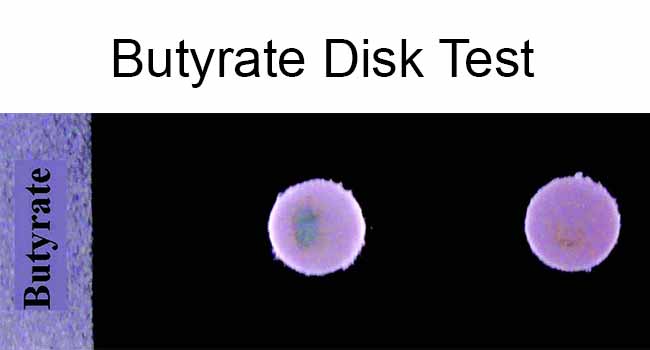Interesting Science Videos
What is Butyrate Disk Test?
Butyrate disk test is a rapid identification test for the detection of Moraxella catarrhalis on the basis of their ability to utilize bromochloro-indolyl butyrate or 4-methylumbelliferyl butyrate.
- Moraxella (Branhamella) catarrhalis is now recognized as a major pathogen that causes otitis media, sinusitis, conjunctivitis, bronchitis, and pneumonia.
- In addition, a large number of M. catarrhalis strains produce the enzyme β-lactamase and thus are resistant against penicillin and ampicillin.
- Conventional tests may require 24 to 48 hours for completion, whereas alternative rapid, easy-to-perform identification methods like butyrate disk tests are desirable.
- In the laboratory, the presence of butyrate esterase is demonstrated by the hydrolysis of substrates like bromochloro-indolyl butyrate or 4-methylumbelliferyl butyrate.
- The test can be performed either via the disk test or the tube method. Both of these tests are the rapid identification test, but the disk test is more feasible as it doesn’t require the preparation of reagents like in the tube test.
- The hydrolysis of the substrate in the disk test can be observed by the fluorescence produced by the products of the hydrolysis.
Objectives of Butyrate Disk Test
- To detect and identify M. catarrhalis from clinical samples as a presumptive identification method.
- To detect the ability of an organism to hydrolyze butyrate substrate by the production of butyrate esterase.
Principle of Butyrate Disk Test
- The butyrate test is a rapid qualitative test for the detection of the enzyme butyrate esterase, which further provides a presumptive identification tool for M. catarrhalis.
- When the test is used along with the characteristic morphology of the organism on blood agar plates, typical Gram stain, and a positive oxidase test, the butyrate test is useful for the definitive identification of Moraxella catarrhalis.
- Both bromochloro-indolyl butyrate and 4- methylumbelliferyl butyrate can serve as substrates.
- The hydrolysis of bromochloro- indolyl substrate by butyrate esterase releases indoxyl, which in the presence of oxygen forms indigo. Indigo is a chromogenic compound that appears blue to blue-violet.
- The hydrolysis of 4-methylumbelliferyl substrate produces a fluorescent compound visible under UV light.
- The hydrolysis is thus detected by the change in color or the detection of fluorescence from the products.
Microorganism Tested
- Gram-negative, oxidase-positive diplococci growing on Blood Agar Plates as white colonies that remain together when lifted with a loop or wire.
Reagents and Supplies Used
Reagent
- Disks impregnated with bromochloro-indolyl butyrate and 4-methylumbelliferyl.
Supplies
- Sterile wooden applicator sticks or bacteriologic loops
- Distilled water
- Petri dish, slide, or tube
- Long-wave (360-nm) UV light
Procedure of Butyrate Disk Test
- The disks are removed from the vial and placed on a clean glass slide or petri dish.
- A drop of distilled or deionized water is added to the disk to moisten it.
- A heavy, visible inoculum is collected with a sterile wooden applicator stick or a loop from a 24 to 72 hours culture and placed on to the disk.
- The inoculated disk is incubated at room temperature (15 to 30°C) for up to 5 min.
- Incubation for slightly longer periods might be required to yield false-positive results.
Quality Control
- The disks should be discarded if they do not appear white with no visible color.
- As a form of quality control, the following organisms can be used for positive and negative results.
- M. catarrhalis ATCC – butyrate positive.
- Neisseria gonorrhoeae or Neisseria lactamica – butyrate negative.
Result and Interpretation of Butyrate Disk Test

Image Source: Bailey and Scott’s Diagnostic Microbiology. Elsevier.
- A positive test results in a blue to blue-violet color (bromochloro-indolyl substrate) or fluorescence (4-methylumbelliferyl substrate) within 5 min, indicating the hydrolysis of bromochloro-indolyl and 4-methylumbelliferyl, respectively, by butyrate esterase.
- A negative test is indicated by the absence of a color change.
Reporting Results
- The result is reported as Moraxella catarrhalis if an oxidase-positive, Gram-negative diplococcus meets the following criteria;
- Grows on BAP as colonies that remain together when sampled and
- Is butyrate positive
- The butyrate-negative colonies that are suggestive of M. catarrhalis can be tested by the above-listed criteria for DNase production. DNase-positive colonies are reported as Moraxella catarrhalis.
Uses of Butyrate Disk Test
- Butyrate Disk Test is used as a rapid presumptive identification test for the detection of M. catarrhalis.
- Butyrate test is also used for the analysis of the ability of organisms to hydrolyze butyrate substrate by the enzymatic action of butyrate esterase.
- The test is also used as a biochemical test for the differentiation between Neisseria gonorrhoeae (negative) and Moraxella catarrhalis (positive), both of which are oxidase-positive, Gram-negative diplococci.
Limitations of Butyrate Disk Test
- The disks should not be incubated beyond 5 min, to avoid false-positive reactions.
- Some strains of other Moraxella species, as well as Eikenella and Acinetobacter, may give a positive or weakly positive reaction.
- The organism must be an oxidase-positive, Gram-negative diplococcus with typical morphology to be accurately identified as M. catarrhalis.
- Other unrelated organisms like Staphylococci and Pseudomonads may also give positive results.
- False-negative tests might result from using too small an inoculum. If the organism is suspected, but the test is negative, repeat with a large inoculum or test for DNase production.
References and Sources
- Perez, J.L. & Pulido, A. & Pantozzi, Florencia & Martin, Roshan. (1990). Butyrate esterase (Tributyrin) spot test, a simple method for immediate identification of Moraxella (Branhamella) catarrhalis. 28. 2347-2348.
- Biochemical Tests for the Identification of Aerobic Bacteria. (2016). Clinical Microbiology Procedures Handbook, 3.17.1.1–3.17.48.3. DOI:10.1128/9781555818814.ch3.17.1
- 2% – https://minimicro.weebly.com/day-7.html
- 2% – http://universe84a.com/butyrate-disk-test/
- 1% – https://www.sciencedirect.com/science/article/pii/0048969794900264
- 1% – https://www.researchgate.net/publication/15535342_Assessment_of_complement-mediated_killing_of_Moraxella_Branhamella_catarrhalis_isolates_by_a_simple_method
- 1% – https://www.chegg.com/homework-help/questions-and-answers/products-hydrolysis-substrate-starch-glycogen-substrate-enzyme-amylase-q16003613
- 1% – https://quizlet.com/306871200/spot-tests-flash-cards/
- 1% – https://microbeonline.com/deoxyribonuclease-dnase-test-principle-procedure-results/
- 1% – https://microbeonline.com/butyrate-disk-test-principle-procedure-results-uses/
- 1% – https://basicmedicalkey.com/neisseria-and-moraxella-catarrhalis/
- <1% – https://www.osha.gov/pls/oshaweb/owadisp.show_document?p_id=10051&p_table=STANDARDS
- <1% – https://www.ncbi.nlm.nih.gov/pmc/articles/PMC476113/
- <1% – https://specialties.bayt.com/en/specialties/q/29703/are-blood-agar-is-a-selective-or-differential/
